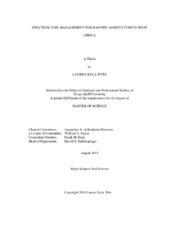| dc.description.abstract | Soil quality enhancements will be a vital link to food security as world populations are projected to swell by 2 billion people over the next 30 years. Efficient and productive agronomic practices will be essential for the subsistence farmers of Sub-Saharan Africa (SSA), where more than half of the estimated population growth is projected to occur. Conservation agriculture and fertilizers offer substantial soil fertility benefits if adopted appropriately for the local physical conditions, climates, crops, and farmer household requirements. The objective of this study is to investigate the effects of tillage method, cropping system, mineral fertilizer, and compost on soil quality in 4 major agricultural regions of Ghana. An ancillary objective is to determine if there was a significant difference in nutrient extraction concentrations from 0.1M HCl extract compared to a cold ultrapure water extract.
Two field experiments were established in 2011 each featuring a split-plot design with three replications per agro-ecosystem. In 2013, soils were collected and analyzed for concentrations of NO3-N, NH4-N, extractable organic nitrogen (EON), extractable organic carbon (EOC), and PO4-P. Findings indicate that agro-ecosystem had a significant effect on soil nutrient concentrations, where the Guinea and Coastal Savannahs had the greatest residual inorganic N, the Forest had the greatest organic C and N, and the Coastal Savannah and Transition had the greatest P concentrations. Within the Coastal Savannah region maize only crop sequence was linked with the greatest amounts of inorganic N, application of urea fertilizer without a P source nor compost correlated with the higher residual inorganic N, and the combination of triple superphosphate (TSP) with an N source was associated with greater inorganic P concentrations. In the Transition zone no-till was associated with high concentrations of inorganic N and P, while the maize-mucuna rotation had high residual inorganic N, and TSP fertilizer was closely linked to greater amounts of inorganic P. Finally, in the Guinea Savannah urea and compost additions are beginning to influence inorganic N soil concentrations and TSP was associated with inorganic P concentrations. | en |


